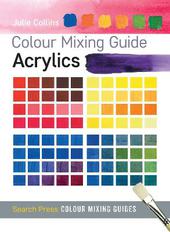
|
Colour Mixing Guide: Acrylics
Paperback / softback
Main Details
| Title |
Colour Mixing Guide: Acrylics
|
| Authors and Contributors |
By (author) Julie Collins
|
| Series | Colour Mixing Guides |
|---|
| Physical Properties |
| Format:Paperback / softback | | Pages:48 | | Dimensions(mm): Height 215,Width 155 |
|
| Category/Genre | Painting and art manuals |
|---|
| ISBN/Barcode |
9781782210559
|
| Classifications | Dewey:751.426 |
|---|
| Audience | |
|---|
| Illustrations |
200 Illustrations, color
|
|
Publishing Details |
| Publisher |
Search Press Ltd
|
| Imprint |
Search Press Ltd
|
| Publication Date |
10 November 2015 |
| Publication Country |
United Kingdom
|
Description
This pocket-sized, practical guide has everything the acrylic artist needs to know about colour mixing, from colour theory to complementary, warm and cool colours, colour tone, using a limited palette, dull and bright colours and local colour. There follows an array of essential colour mixes using widely available Winsor & Newton colours. Clear, practical and beautifully presented advice.
Author Biography
Julie Collins studied Fine Art at the University of Reading and has been an artist, writer and teacher since then. She has written colour mixing and artist's problem solving books and writes for The Artist magazine. She works from her studio in Farnham, Surrey, where she explores her passion for painting, drawing and crafts.
ReviewsDecember 2016 Julie Collins' previous book on colour mixing with watercolours was reviewed in our December 2015 issue. The latest book on Acrylics is a good addition to the series. It follows the same structure as the Watercolours book, using a limited palette (this time thirteen colours plus white) from primary and secondary colours but as a different medium, producing different colours and results. The book explores the colour wheel, tone and dulling colours before moving onto the colour mixing catalogue. This book is a handy reference tool for planning a colour scheme and would be useful for creating a many layered piece for mixed media work. Julie Collins makes the point at the beginning that you need to spend time mixing your colours in order to make the right choices for a piece of work. She likens it to an athlete warming up before a race rather than rushing into a 100m sprint. It's a great metaphor to consider when approaching colour. * Workshop on the Web * January 2016 Julie Collins' handy pocket sized guide to mixing acrylic colours contains 48 pages packed full of advice on mixing acrylic colours for all possible uses. There's information on colour theory, complementary colours, warm and cool colours, colour tone, using a limited palette, dull and bright colours and using local colour. Julie uses readily available Winsor & Newton colours and presents the information in a clear practical way. A colour wheel and template are included so that readers can paint their own colour wheel. * The Leisure Painter * Colour mixing guides take the mystery and chemistry out of the process to provide you with easy mixes giving you the colours you want. Colour theory is included. It uses widely available colours. When you need spot-on, repeatable colours, you'll find this book essential. It's easy to use with very clear instructions * Karen Platt- yarnsandfabrics.co.uk *
|